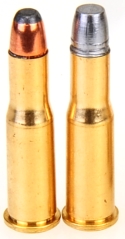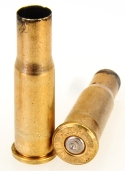 Firearms represent history and the Savage 23B is no exception. As the subtitle infers, there were lots of things going on when Savage decided to manufacturer this model. It’s got an interesting look, it is overbuilt for the cartridge and the long 25″ barrel makes for some exceptional 25-20 WCF ballistics without pushing any limits.
Firearms represent history and the Savage 23B is no exception. As the subtitle infers, there were lots of things going on when Savage decided to manufacturer this model. It’s got an interesting look, it is overbuilt for the cartridge and the long 25″ barrel makes for some exceptional 25-20 WCF ballistics without pushing any limits.
The 25-20 WCF was initially introduced for the Winchester Model 1892, but it quickly was adopted by other manufacturers like Marlin, Remington and Savage for use in lever, pump and bolt action firearms. It made for a great small game and varmint rifle, although it is reported to have accounted for more than its fair share of deer.

The 25-20 WCF has a case capacity of approximately nineteen grains, about five more than the 22 Hornet and three less than the 256 Winchester Magnum. The case takes a small rifle primer and bullet weights in the range of sixty to eighty-six grains, both jacketed and cast.
Ammunition and reloading components are available through online retailers at prices comparable to cartridge of similar size and power.
Reloading dies are readily available from all major die suppliers with three die sets including a factory crimp die, priced at $28. Nothing special required. In this case, ammo was loaded with RCBS dies, but it could have just as easily been Hornady, Lee, Lyman, or Redding.
In general, the 25-20 WCF is one of the easiest cartridges to handload and one of the least expensive, roughly $3/20. Brass lasts a long time and bullets are cheap, even when the construction and quality is premium. The loads noted below were in keeping with the cartridge’s SAAMI maximum pressure of 39,000 PSI, however that applies to this rifle and the caution that follows applies.
Ammunition slated for lever action rifles with tubular magazines requires flat nose bullets. Ammunition slated for bolt action rifles like the Savage Mode 23 B does not. However, the short COL and modest capacity means that short, flat base, lead core bullet at the lower end of the 0.257″ bullet range are required. There are actually quite a few to select from. None have a particularly high BC or SD, but they fly better than flat nose bullets.
Warning: Bullet selections are specific, and loads are not valid with substitutions of different bullets of the same weight. Variations in bullet length will alter net case capacity, pressure and velocity. Primer selection is specific and primer types are not interchangeable. These are maximum loads in my firearms and may easily be excessive in others. All loads should be reduced by 5%, and developed following safe handloading practices as represented in established reloading manuals produced by component manufacturers. Presentation of these loads does not constitute a solicitation for their use, nor a recommendation.
|
Cartridge: 25-20 WCF |
|
| |
|
| |
|
| |
|
| |
|
|
Bullet, case and COL – SAAMI Specifications Groups shot with open sights |
|
| Bullet Type | Bullet Weight Grains |
Net Water Capacity Grains |
COL” | Powder Type | Powder Charge Grains |
Muzzle Velocity fps |
Muzzle Energy ft/lbs |
50 Yard Group Size 3 Shot “ |
|
| Hornady FP | 60 | 15.9 | 1.605 | H110 | 14.5 | 2732 | 995 | 1.1 | |
| Hornady FP | 60 | 15.9 | 1.605 | Lil’ Gun | 14.0 | 2787 | 1035 | 1.2 | |
| Hornady HP | 75 | 12.5 | 1.592 | H110 | 11.6 | 2278 | 864 | 1.1 | |
| Hornady HP | 75 | 12.5 | 1.592 | Lil’ Gun | 11.5 | 2363 | 930 |
0.9 | |
| Sierra HP | 75 | 12.6 | 1.592 | Lil’ Gun | 11.6 | 2372 | 937 | 0.8 | |
| Sierra HP | 75 | 12.6 | 1.592 | Win 296 | 11.7 | 2337 | 910 | 1.0 | |
| Hard Cast FP | 83 | 13.8 | 1.592 | 2400 | 10.0 | 2103 | 815 | 1.7 | |
| Hard Cast FP | 83 | 13.8 | 1.592 | Lil’ Gun | 12.5 | 2467 | 1122 | 0.9 | |
| Hard Cast FP | 83 | 13.8 | 1.592 | Win 296 | 12.5 | 2332 | 1003 | 1.1 |
Makes a difference
| Indices | Hornady 75 Grain Range 0 -300 yards | ||||||
| Range -yds | 0 | 50 | 100 | 150 | 200 | 250 | 300 |
| Velocity – ft./sec. | 2363 | 2206 | 2055 | 1911 | 1773 | 1642 | 1520 |
| Energy – ft.-lbs. | 930 | 810 | 703 | 608 | 524 | 449 | 385 |
| Path – in. | -1.5 | 1.8 | 3.4 | 2.9 | -0.0 | -5.7 | -14.6 |
| Indices | Hard Cast 83 Grain Range 0 -300 yards | ||||||
| Range -yds | 0 | 50 | 100 | 150 | 200 | 250 | 300 |
| Velocity – ft./sec. | 2467 | 2156 | 1869 | 1608 | 1383 | 1202 | 1073 |
| Energy – ft.-lbs. | 1013 | 774 | 582 | 431 | 318 | 241 | 192 |
| Path – in. | -1.5 | 2.4 | 4.4 | 3.9 | 0.0 | -8.5 | -22.9 |
 For handloaders with a non-tubular magazine as the end destination for ammo, soft points with a better ballistic coefficient can start off slower and still win the race by a large margin. On the tables above, the 75 grain Hornady retails almost twice the kinetic energy of the hard cast 83 grain and approximately 50% greater velocity.
For handloaders with a non-tubular magazine as the end destination for ammo, soft points with a better ballistic coefficient can start off slower and still win the race by a large margin. On the tables above, the 75 grain Hornady retails almost twice the kinetic energy of the hard cast 83 grain and approximately 50% greater velocity.  Big numbers for a small cartridge. The most consistent powder was Lil’ Gun with Win 296 a close second. It also happens to be the velocity leader also. Fifty yard accuracy through this eighty plus year old rifle with metallic open sights was excellent.
Big numbers for a small cartridge. The most consistent powder was Lil’ Gun with Win 296 a close second. It also happens to be the velocity leader also. Fifty yard accuracy through this eighty plus year old rifle with metallic open sights was excellent.
Charges should be precisely metered. With small cases, a fraction of a grain changes pressure in a meaningful way and it is easy to get symptoms of excessive pressure, like primers flowing into firing pin holes. That said, I’m going to look for more of these older rifles. They have a lot of personality.
The New 25-20 Winchester Magnum! Part 1
The New 25-20 Winchester Magnum! Part 2

Email Notification